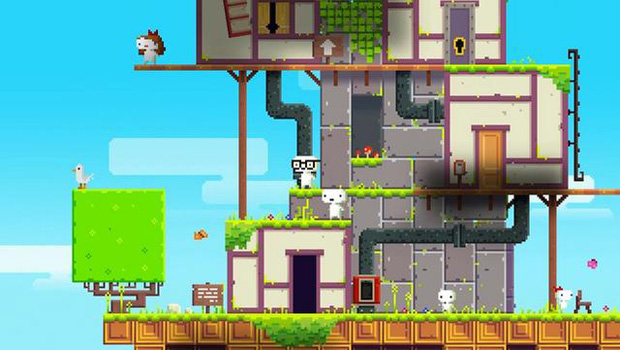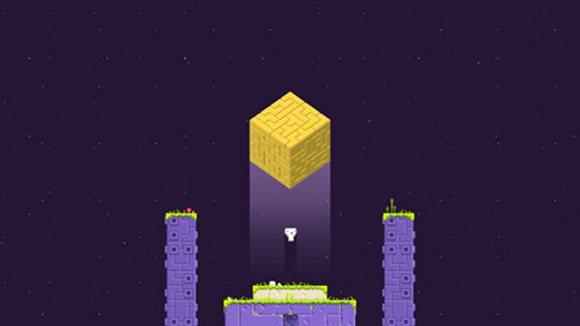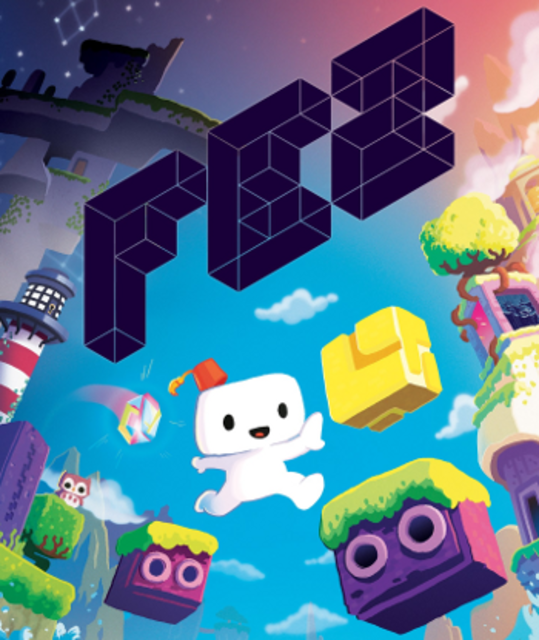
Fez requires you to change your perspective.
You start in Gomez’s small room. Presented as a flat 8-bit, 2D side-scroller, the room is clean and well decorated, but is obviously a child’s. Gomez can run and jump but his only initial act is to leave. Outside is the beautiful, vertically oriented village and kind but simple residents. You are beckoned to the top of the village from a mysterious old man with an eye patch and a small red fez. He tells you that it’s an important day. That’s when the Hexahedron appears.
It speaks but its words are unintelligible. When it has quieted, it gives Gomez an identical red fez the old man had. As it drops on Gomez’ head, he finds that he is able to perceive a new dimension to the world he had known and that he can walk in directions he never could before. But it’s too much for him to handle and his reality falters, the data now corrupted. The Hexahedron shatters into small Cubes and many of those break into smaller Bits. The force scatters them about the world. The system crashes and we are met with a boot screen. When Gomez comes to, he finds he still has the power. He finds that there is more to his room than he’d seen.
The village isn’t any more complex than it had always been- he’s just now able to see that there is so much more to it. That includes the door at the bottom that hadn’t ever been accessible, the only way out. Only by collecting enough Bits to build a Cube will the door unlock. But it can only be reached by those who see that there is an entire world waiting on the other side and are brave and curious enough to open it and step through. To reassemble the Hexahedron, Gomez leaves the only home he’s ever known.
A minute later, he’s on a beach, its primary landmark a lighthouse. The water stretches out far into the distance and that there’s so much beyond the village. Someone must have built this lighthouse but none of your neighbors had come this far. This is the first evidence that another civilization exists, but you soon encounter more- the mines that exhibit industrialization and development; the sewers, a sign of infrastructure; the observatory pointed to the heavens and the promise of science; the graveyard filled with the people that came before and, with it, the implication of history.
Your travels will unearth tangible pieces of that history through maps, keys and artifacts. These items hide secrets but they are each more cryptic than the last. The Counting Cube’s symbols are discernible, but don’t reveal much meaning. One cave has what appears to be a shrine with blocks. Assembling the blocks into one form whose shape differs depending on the viewing angle earns an Anti-Cube. The remnants of the civilization are everywhere and the sense of loneliness is foreboding, almost ominous.
Then you find the other village. You enter and see that while the architecture looks different, it’s residents don’t. Speaking to them is a stalemate; you don’t understand their language, they don’t yours. You also find another door, one that requires 32 Cubes. As it opens, you realize that while your adventure started in your small corner of the world, it ends in someone else’s.
The reward is a dizzying lightshow. Met with a stream of information, the universe opens itself up. When Gomez met the Hexahedron, he was granted the kernel of consciousness, and it proceeded to develop as he made new discoveries and travelled to new places. At the end it fully forms and explodes out into self-awareness.
To collect the 32 cubes needed to complete your journey, you’ve explored most every location and room. You know the world but you don’t know its secrets. Finishing once opens up New Game+ and a new gift from the stranger- a pair of cool shades. As he puts them on, Gomez no longer looks like a child. And with the glasses comes a new perspective to see that now familiar world; the ability to go into first person and discover what lies in the areas that were once obscured. And then the game crashes again. The new view further hints at the underlying scope of the game, but you have to actively seek it on your own. Fez is about changing your perception of the world around you, about going in new directions and to new places both geographically and intellectually.
Fez invites you to change your perspective.
The second adventure is a mental one- a quest for 32 devilishly well-hidden Anti-Cubes and every single one a puzzle, the bulk of which are based on inputting a unique code. Every code depends on the specific puzzle but each is derived from one of several cyphers that can be found in the world. Each time you deduce a new cypher, the sense of pride is equal only to the influx of information now available to you.
What you find is that their language is built on an alphabet consisting of the many square symbols spread about the world. You haven’t been able to communicate but that doesn’t mean their culture is impenetrable. A mural suggests a complex social hierarchy and defined class lines; it looks like they have a king but the throne room is empty, the stone seat cold. You find that their numerals are based on dimensionality, that their alphabet can be translated by breaking the code on a certain picture or solving a game-long cryptogram. You also find that your actions impact this world and that each action you perform has a defined spatial value and are represented symbolically as the classic Tetris pieces. You remember that you’ve seen these pieces all over the game, etched into the environment in long chains. Inputting the proper sequence at each location reveals its treasure.
But these symbols are strange. They are carved into walls, into the ground. They’re etched into monuments. They have a special significance in the land. They’re revered. It’s confirmed when you climb to the observatory and peer through its lens. The night sky glows in the light of the constellations, all shaped like Tetris pieces. The heavens are filled with geometry. This spirituality pulses throughout the game. It is existential theory using math, not science; numerology, not astronomy. It’s also sign of a world that is far more complicated than you imagined before you left your small village.
Fez was a platformer. Fez was a puzzle game. Now you realize what Fez really is- a parable. He left a child and grew from his experiences into a conscious individual- one that is aware of himself, society and reality. Over the course of his adventure, Gomez had grown up. This underlying narrative has also been carried by clever implementation of its retro aesthetic and its dedication to simulating old technology.
At the beginning, the game was as an unassuming 2D side-scroller made of pixels. The processor was simple and saw its world in kind. But it crashed under the strain of a new perspective. The processor became stronger and revealed polygons and a depth to the universe. A similar revelation would happen again during the change to full 3D rendering. This system crash-and-reboot sequence is a story-telling device that not only acts as a metaphor for the evolution of videogame technology but applies itself directly to the narrative. The processor is Gomez’s brain, one that became more and more complex with every step he took, every puzzle he solved. That’s what all the bits and cubes did- they added power to the processor and it found new perspectives.
But it didn’t have to be that way. Gomez could have simply jumped and played without ever looking for the substance underneath. Those that identified the questions and sought out the answers understand what was waiting for them, a world rich in information and knowledge. The adventure ends at the threshold to maturity; an age old enough to push forward in new and exciting directions but with the innocence and optimism of youth. He is not yet like the one-eyed man, who has already lived his life and had his adventures, no longer able to change his perspective. For now, he sees a world that is often colorful, sometimes scary and frequently mysterious- but always beautiful.
Fez challenges you to change your perspective.
WRITER: Phil Fish

*this post and more can be found at Script Routine.

Log in to comment